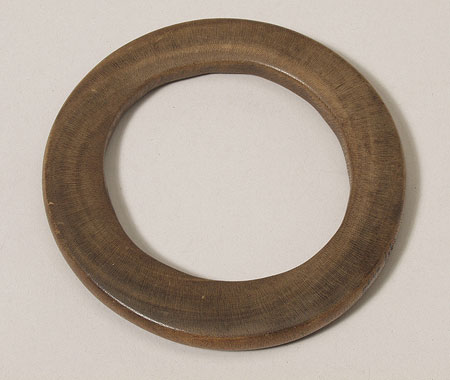Accession Number:
1917.25.85
Country:
Sudan
Region:
[Southern Sudan]
Cultural Group:
Dinka
Date Made:
By 1917
Materials:
Wood Plant
Process:
Carved , Polished
Dimensions:
Outer dimensions 104.2 x 102.3 mm, Ht 11 mm [RTS 25/3/2004].
Weight:
24.3 g
Other Owners:
Robert Grenville Gayer-Anderson, probably collected in the period immediately before World War I (1909-1914) [RTS 1/6/2004].
Field Collector:
Robert Grenville Gayer-Anderson
PRM Source:
Robert Grenville Gayer-Anderson
Acquired:
Donated 1917
Collected Date:
By 1917
Description:
Annular arm ornament, carved from a single piece of wood into a nearly circular ring with flat upper and lower surfaces, a flat inside face, where the object would rest against the arm or wrist, and slightly convex outer face.
One side of the ring is broader than the other.
The surface is polished, and the object is complete and intact, except for a few small chips missing from some surfaces.
The wood is a yellowish brown colour (Pantone 464C) except on the upper surface, which has been partially stained dark brown (Pantone 412C).
The length across the outer edges is 104.2 mm, and the width 102.3 mm; the inside diameter is 72 mm.
The ring is from 14.3 to 17.7 mm thick, and has a height of 11 mm, and the armlet weighs 24.3 grams.
Collected by Robert Grenville Gayer-Anderson, probably between 1909 and 1914, in the period immediately before World War I, somewhere in the ‘White Nile’ region. Throughout the twentieth century the term ‘White Nile’ has been used to denote an administrative district immediately south of Khartoum. However at the time this object was collected the term was also used more loosely to refer to the Bahr el Abiad and Bahr el Jebel rivers, or the areas immediately around them, and association with the Dinka suggests this is probably the case here.
Currently on display in the Upper Gallery, Case 26A.
Rachael Sparks 17/9/2005.
Collected by Robert Grenville Gayer-Anderson, probably between 1909 and 1914, in the period immediately before World War I, somewhere in the ‘White Nile’ region. Throughout the twentieth century the term ‘White Nile’ has been used to denote an administrative district immediately south of Khartoum. However at the time this object was collected the term was also used more loosely to refer to the Bahr el Abiad and Bahr el Jebel rivers, or the areas immediately around them, and association with the Dinka suggests this is probably the case here.
Currently on display in the Upper Gallery, Case 26A.
Rachael Sparks 17/9/2005.
Primary Documentation:
Accession Book Entry
[VI, p.
54] - 1917 [pencil insert] 25 [end insert]
MAJOR R.G.
GAYER-ANDERSON
, R.A.M.C.
The Lodge, Old Marston, Oxon [pencil insert, p.
56] 85 [end insert] - Armlet of wood (?) Dinka.
Additional Accession Book Entry [page opposite 54] - A gift to the Pitt Rivers Museum in memory of Major R.G. Gayer-Anderson, Pasha, his twin brother Colonel J.G. Gayer-Anderson, C.M.G., D.S.O.
Card Catalogue Entry - ANGLO-EGYPTIAN SUDAN, WHITE NILE, DINKA. Armlet of wood (?). d.d. Major R.G. Gayer-Anderson, 1917 [RTS 9/3/2004].
Related Documents File - Two letters dated 30/03/1917 and 13/04/1917 from the donor to Henry Balfour regarding the donation of the collection to the museum [EB 12/11/2001]. These indicate that the material was collected by Robert Gayer-Anderson himself, chiefly from the areas of Nuba, Kordofan and Bahr el Ghazal during 5 years he spent in the Sudan, and that they were given to the museum as an unconditional gift. His biography indicates that this material was probably collected in the years just before World War I (1909-1913, or 1910-1914?) [RTS 5/12/2003]. The note in the accession book calling this gift 'in memory of' R.G. Gayer-Anderson is therefore somewhat enigmatic, as both Robert and his twin brother (Thomas G., not J.G.) were alive at the time of the transfer [RTS 5/12/2003].
Written on object - DINKA armlet. WHITE NILE. d.d. Major R.G. Gayer-Anderson, 1917.25.85 [RTS 17/3/2004].
Additional Accession Book Entry [page opposite 54] - A gift to the Pitt Rivers Museum in memory of Major R.G. Gayer-Anderson, Pasha, his twin brother Colonel J.G. Gayer-Anderson, C.M.G., D.S.O.
Card Catalogue Entry - ANGLO-EGYPTIAN SUDAN, WHITE NILE, DINKA. Armlet of wood (?). d.d. Major R.G. Gayer-Anderson, 1917 [RTS 9/3/2004].
Related Documents File - Two letters dated 30/03/1917 and 13/04/1917 from the donor to Henry Balfour regarding the donation of the collection to the museum [EB 12/11/2001]. These indicate that the material was collected by Robert Gayer-Anderson himself, chiefly from the areas of Nuba, Kordofan and Bahr el Ghazal during 5 years he spent in the Sudan, and that they were given to the museum as an unconditional gift. His biography indicates that this material was probably collected in the years just before World War I (1909-1913, or 1910-1914?) [RTS 5/12/2003]. The note in the accession book calling this gift 'in memory of' R.G. Gayer-Anderson is therefore somewhat enigmatic, as both Robert and his twin brother (Thomas G., not J.G.) were alive at the time of the transfer [RTS 5/12/2003].
Written on object - DINKA armlet. WHITE NILE. d.d. Major R.G. Gayer-Anderson, 1917.25.85 [RTS 17/3/2004].
Display History:
Current display label - Because this object was marked with the incorrect accession number (1917.25.84) it has been displayed in case U.26.A with an incorrect display label, from the time the display was created.
This incorrect label read: SUDAN, BAHR EL JEBEL, DINKA.
Arm ornament made from a part of an elephant's hoof.
Donated by Major R.G.
Gayer-Anderson, 1917.25.84 [RTS 10/5/2004].
Note that this was slightly incorrect in any case, as the original record for 1917.25.84 in any case gives the provenance as 'White Nile', not 'Bahr el Jebel'.
This label needs to be corrected [RTS 10/5/2004].



